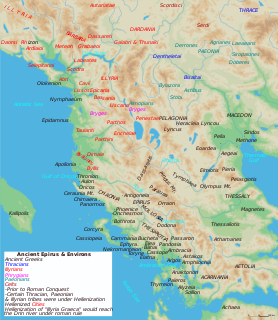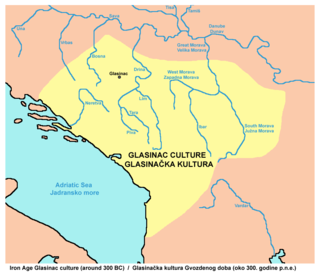 W
WThis is a list of ancient tribes in the ancient territory of Illyria. The name Illyrians seems to be the name of a single Illyrian tribe that was the first to come into contact with the ancient Greeks, causing the name Illyrians to be applied to all people of similar language and customs. The locations of Illyrian tribes/peoples prior to the Roman conquest are approximate, as sometimes many wholly different locations are given by ancient writers and modern authors.
 W
WThe Ardiaei were an Illyrian people residing on territory of present-day Albania, Kosovo, Montenegro, and Bosnia and Herzegovina between Adriatic coast on the south, Konjic on the north, along the Neretva river and its right bank on the west, extending to Lake Shkodra to the southeast. From the 3rd century BC to 168 BC the capital cities of the Ardiaean State were Rhizon and Scodra.
 W
WBanja of Peja is a township located in the municipality of Istok, Kosovo. To many people it is known by the name Ilixhe. It is a tourist health center with services in Istok and in the region, offering quality for inhabitation, highly developed infrastructure and services.
 W
WPart of a series of articles upon Archaeology of Kosovo
 W
WThe Glasinac culture or Glasinac group, was an Iron Age archaeological culture named after the Glasinac locality in Bosnia and Herzegovina.
The Harilaq fortress, is situated on top of the hill known by the local toponomy as the Gradina – Harilaq, set in an elevated and dominant position, west from the Ariljača village. The fortress is located in an altitude of maximum 766 metres above sea level, and is approximately sited 9 km southeast from the town of Kosovo Polje and only 2 kilometres west from Pristina International Airport "Adem Jashari". The total surface of the fortress, also counting the circular walls/ ramparts, measures around 1.3 hectares of the inner space of the stronghold. The archaeological excavations at this site were conducted in several seasons, commencing in 2005 and were carried out systematically until 2010 by the staff of the Museum of Kosovo, particularly the Archaeological Institute of Kosovo. Nonetheless, several conservations and consolidations of the circuit walls were done in order to preserve the remains. During the five archaeological seasons' works, numerous remains and foundations of sacral, profane and utilitarian buildings were discovered. In regard, the entire outer sides of the rampart with towers at the axes were unearthed, as well as a church with three naves and a Saskrity are discovered, but also two almost identical structures in a rounded shape of an unknown sacral complex has been uncovered, as well. On the other hand, vast movable archaeological material composed of: metal made working tools, jewelry, coins, bricks, glass fragments and architectural structures, all clear indications that pinpoint to the Late Antique date and especially typical for the Justinian Period. Also, at this fortress traces of prehistoric periods have been evidenced, especially emphasizing the metal periods, but it continued to exist all through antiquity and up to the Medieval Period. Discovered and recorded findings from this site of excavations from 2005–2008 were presented at the International Conference on Illyria: Illyri Meridionale et l'Epire dans l'antiquite, Act du V colloque internacional de Grenoble, 8–11 octobre 2008, held in Grenoble, France.
 W
WPart of a series of articles upon Archaeology of Kosovo
 W
WPart of a series of articles upon Archaeology of Kosovo
 W
WPart of a series of articles upon Archaeology of Kosovo
 W
WPart of a series of articles on Archaeology of Kosovo
 W
WPart of a series of articles upon Archaeology of Kosovo
 W
WPart of a series of articles upon Archaeology of Kosovo
 W
WRomajë is a village in the Prizren municipality of Kosovo. It has 2,747 inhabitants as of 2011. The area of Romajë is the site of a multi-layered settlement of the pre-Roman Iron Age, the Roman era, and the medieval era. Excavations at the necropolis of Romajë have revealed extensive burial mounds (tumuli) of classical antiquity.
 W
WDardania fell under Roman occupation in the first century AD, one of the last territories of Illyria to succumb. Being that Dardania had and today Kosovo has a central position between the road networks that connected the south Aegean with the Danube basin, and with the Adriatic Sea, it was a strategic jewel. It also was important for the Romans due to its rich mineral resources, which they exploited and benefited from. We see that most of the towns of ancient Dardania are located either close to a mine, or close to a road. The Dardanian identity has been disputed for a while, and it is known that it was distinctive, similar to the Illyrian, and also with a Roman or Thracian twist to it, due to the occupation and co-habitation. The archaeological surveys and studies of the last century are helping to establish this Dardanian identity in an objective manner, which will lead to a clearer study and explanation of the continuity of culture in this so much disputed region. Below is a listing of the prominent settlements during the Roman period and an explanation of what they were, when they were inhabited, and when they were founded, accompanied by an array of pictures that illustrate the archaeological finds and remnants.
 W
WUlpiana was an ancient Roman city located in what is today Kosovo. It was also named Justiniana Secunda. Ulpiana is situated in the municipality of Lipljan. In 1955, under Resolution No.v.E.K.21/55, Ulpiana was added to Serbia’s Archaeological Sites of Exceptional Importance list.
 W
WPart of a series of articles upon Archaeology of Kosovo
 W
WVlashnjë is a village in the Prizren municipality of Kosovo. It has 1,700 inhabitants as of 2011. Vlashnjë is a multi-layered settlement and site area. Archaeological excavations have identified habitation and use of the area since the Neolithic era. The rock art paintings at Mrrizi i Kobajës are the first find of prehistoric rock art in Kosovo. In late antiquity, Vlashnja was a fortified settlement part of the fortification network which Justinian I rebuilt along the White Drin in Dardania.